
The 4-O Ranch Unit is high quality riparian habitat, native grasslands, Ponderosa pine woodlands, wildflower meadows, curl-leaf mountain mahogany stands, and talus slopes and cliffs. It provides important year-round habitat for deer, elk, and, bighorn sheep. This unit includes 10 miles of river and creek habitat, with parts of the Wenatchee, Cougar, Grouse, and Medicine Creek drainages, tributaries, and shorelines of the Grande Ronde River, which is a tributary of the Snake River. The Grand Ronde is home to steelhead and bull trout, both federally listed as threatened and managed as state species of concern, as well as redband rainbow trout and many other fish and aquatic species.
This unit is located on the southern end of Asotin County. The unit can be accessed from the Grande Ronde River Road off of Highway 129.
The 4-O Ranch Unit is located in the Snake River Watershed, within the Columbia River Basin, the unit sits along the Grand Rounde River. The Umatilla National Forest lies to the north, other public lands include the Bureau of Land Management. Surrounding land ownership is rural agriculture.
This unit is part of the Chief Joseph Wildlife Area.
Game Management Unit: 172
Getting there
Maps and directions to WDFW-managed access points for this unit. Opens Google Maps in a new tab.
Recreation and public access
A Discover Pass is required on WDFW lands -- including water access areas, wildlife areas, and campgrounds -- unless you already have a Vehicle Access Pass issued with the purchase of an eligible hunting or fishing license. Recreate responsibly on public lands: please know the Public Conduct Rules.
Public facility information:
- Autrey Campground (accessed via Cougar Creek Road) has 8 campsites, pit toilet latrine, and hitching post
Recreation and access advisories
- Motorized travel is allowed only on county roads.
- Snowmobiling is prohibited.
- This unit is open year-round, but snow may impact motorized vehicle travel in winter.
Hunting
For all species other than deer and elk, the hunting seasons and fishing access are consistent with current general season regulations and management needs.
Hunting advisories
- A SAFETY ZONE is established at Bott Fields, near an existing house. No weapons may be discharged within this zone.
- For hunting and fishing access information, please see the Annual Fishing and Hunting Regulations.
Fishing
Steelhead and bass fishing on the Grand Ronde is popular.
Wildlife viewing
This unit has 10 miles of river/creek with high-quality riparian habitat, and also has native grasslands, Ponderosa pine woodlands, wildflower meadows, curl-leaf mountain mahogany stands, and talus slopes and cliffs, offering opportunities to view a variety of wildlife, including black bear, cougar, mule deer, elk, bighorn sheep, golden eagle, and northern goshawk.
Search for potential birding opportunities on or near a wildlife area unit by using eBird Northwest, a citizen science database portal that provides freely-shared bird lists at 'hotspots' and interactive maps plus other birding information updated daily.
Other recreational opportunities
Trails offer opportunities for horseback riding.
Conservation
This unit provides provides important winter range for elk and mule deer, and year-round habitat for bighorn sheep. It is also home to steelhead and bull trout, both federally listed as threatened and managed as state species of concern, as well as redband rainbow trout and many other fish and aquatic species.
Special habitats and species
High quality riparian habitat including curl-leaf mountain mahogany stands, native grasslands and Ponderosa pine woodlands are found on the unit. Eight rare plants have been documented.
Conservation goals
- Improve habitat for mule deer populations
- Maintain healthy bighorn sheep population by communicating risks from domestic animals to the public
- Conduct an assessment of native prairie habitat by 2022; and by 2024, develop a strategy to protect and restore native prairie habitat
- Develop plan to survey entire wildlife area for rare plants by 2024
- Implement the Forest Management Plan
- See WDFW's Forest Health Story Map for more information.
High quality riparian habitat including curl-leaf mountain mahogany stands, native grasslands and Ponderosa pine woodlands are found on the unit. Eight rare plants have been documented.
- Improve habitat for mule deer populations
- Maintain healthy bighorn sheep population by communicating risks from domestic animals to the public
- Conduct an assessment of native prairie habitat by 2022; and by 2024, develop a strategy to protect and restore native prairie habitat
- Develop plan to survey entire wildlife area for rare plants by 2024
- Implement the Forest Management Plan
- See WDFW's Forest Health Story Map for more information.
Land stewardship
The 4-O Ranch Unit was acquired to protect native habitat and federally listed fish and wildlife species.
Acquisition history
The parcels making up this area were purchased between 2012 and 2016.
| Funder | Fund |
|---|---|
| US Fish and Wildlife Service | Endangered Species Act Section 6 Program |
| US Fish and Wildlife Service | Pittman-Robertson Wildlife Restoration Program |
| WA Recreation and Conservation Office | Washington Wildlife and Recreation Program |
Management planning
2019 Blue Mountains Wildlife Areas Management Plan
Every eight to 10 years, the Washington Department of Fish and Wildlife (WDFW) revises management plans for each of its 33 wildlife areas to document current conditions, address new agency initiatives, and identify new management priorities and actions. In between those major revisions, WDFW updates plans every two years to outline short-term objectives and accomplishments. In 2014, WDFW began the process of updating existing plans, many of which were written in 2006. The new plans are being developed with significant public participation and input.
Planning Advisory Committee
Chief Joseph/Asotin Creek Wildlife Area Advisory Committee